The Complete Guide to Using Geotargeting to Get Customers Into Stores
February 17, 2022 by
Since the onset of the pandemic, advertisers and brands have tried new targeting tactics and tested different strategies to see what works and what doesn’t amid new consumer behaviors. As has always been the case, advertisers who are thinking creatively and strategically are those who are succeeding and growing.
As geotargeting experts, we have compiled a guide on our best strategies to use location-based marketing to get people back into stores, to keep your customers informed and your business top of mind.
Reaching Loyal Customers
The core value of location-based marketing and geotargeting is the ability to build audiences of past visitors. Welcome them back by offering them deals on their favorite comfort meal, or enticing them with the latest trends.
We created a few examples so you have an idea of the scalable, addressable audience you could create for your brands.
Restaurants
Yard House can reach more than 59,000 diners and beer drinkers who were in their restaurants.
Hair Salons
Supercuts can reach almost six million people who were in their stores.
Apparel
American Eagle can entice 56,115 people who visited their stores in the Chicago area.
Homegoods
IKEA can advertise to more than 300,000 people who browsed the San Diego store.
Consumer Electronics
Best Buy can bring back nearly 9,000 shoppers to their stores in Boston.
Pet Supplies
PetCo can reach more than 37,000 pet lovers in Albuquerque, NM.
Theme Parks
Six Flags can reach 7,500 of last summer’s visitors to come back when they open.
VISIT Local lets you see and reach the audiences you need to get your business back to normal.
Win Over New Customers
Whether you are opening after your competition and want to target their customers or want to look back to target those who visited your competitors before the pandemic, location-based marketing is a way to achieve this. If they’re already visiting and buying from the competition, they are likely open to considering you as an alternative. Chances are, if you like tacos from one chain, you’re likely willing to try new, better tacos.
This strategy works for almost all consumer industries. We have a great example of how Moe’s Southwest Grille used this tactic to increase conversions by 67%! Read the case study.
Reaching Locals
Most consumers aren’t leaving their house as often if they’re still working from home. The best way to reach customers in this context is to geotarget those who live within a few miles of your locations.
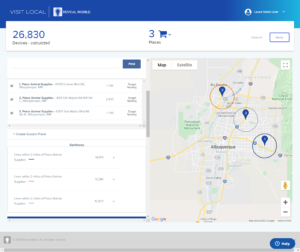
This can help build community and tap into the convenience factor people need. Reaching locals is also a great way to build new business. There may be people who live nearby who have never heard of your store or restaurant, so let them know you’re there and within a few minutes drive.
On the other hand, a commuter may have driven by your business twice a day every day for years but have never stopped in. Since they are working from home and no longer driving by, you are no longer top of mind. Reach these people to let them know you are open and all the goodies you have to offer.
Thinking Outside the Geofence
The most accurate geofences have always been polygons of the actual footprint of a building. Now, marketers have to think outside the geofence to capture curbside pick-up areas, drive-throughs, and outdoor seating.
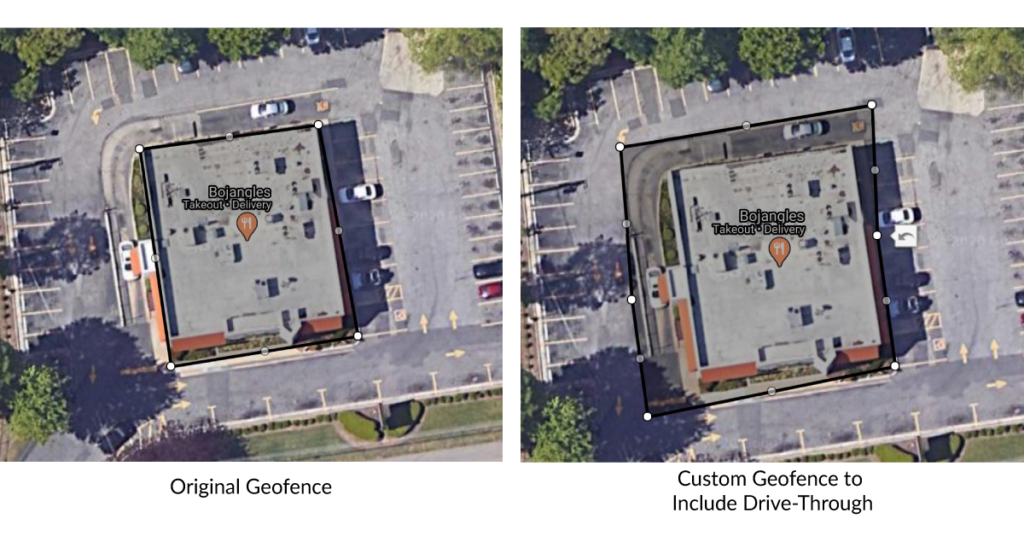
Home Depot, Target, Walmart and even your favorite local cafe are offering curbside pick up. Since these people are taking advantage of that service and not stepping foot into the store, a custom polygon will be needed to capture the pickup zone.
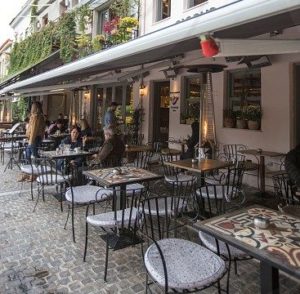
Depending on the point of interest database you have access to, restaurant and bar geofences likely only capture the building and may not include the patio, especially if it is a new addition built for reopening. Drawing a custom polygon ensures you are able to capture and reach as many visitors to those locations as possible, including all of the outdoor eating spaces.
Access Those With An Affinity for Your Brand
If the category you or your client are in still has limitations, or was late to open, you can reach people where they are actually going. Getting creative and making the connection between your brand and where audiences are going will help you reach people with an affinity for your brand.
Here are a few examples of the connection you can make.
- Parks and walking trail visitors – targets for fitness, outdoor apparel and equipment, vacations and destination travelers
- Liquor stores – targets for online wine and alcohol subscription services, breweries, wineries, distilleries
- Moving truck rental locations – targets for new household products, such as furniture, dishware, appliances, lawn and garden supplies, indoor paint, and soft goods
We dive deeper into these ideas and more in this blog post, Finding High-Intent Audiences When Foot Traffic is Down.
You Have the Ultimate Audience, Now What?
Now that you have a full utility belt of tactics to build the ultimate location-based audience, you are likely wondering how to serve ads to this high-intent audience.
Location-based marketing is completely based on privacy-compliant location data derived from mobile ad IDs (MAIDs). MAIDs are anonymized unique identifiers from smartphones used for advertising.
Most DSPs as well as social media ad platforms accept MAIDs as a custom audience. This kind of custom audience helps to cut out the noise and ensure you’re reaching the people most likely to convert. Learn more about using custom audiences on social media.
1. Customize your audience
Once you have added your creative to the campaign with your custom audience selected, you can also narrow your audience by adding demographic or interest targeting on top of it, or expand your audience by adding a lookalike. Select your budget and placement and hit play! Read the case study about success with location-based audiences on social media.
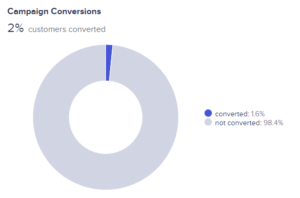
2. Measure your success
It’s one thing to see impressions and click rates in the campaign reporting. But when your goal is to drive in-store foot traffic, or curbside pick-up, Facebook and the like cannot tell you how your campaign performed. Foot traffic attribution reporting ties your digital campaigns to real-world conversions.
Check out our whitepaper Foot Traffic Attribution and the Digital Marketer for more information.

3. Add pixel tracking
Include pixel tracking for even more accurate campaign and conversion tracking. Adding a pixel to your ads will track who actually saw your ad and converted or not.
Practical Campaign Examples
Restaurants
Using high-level foot traffic analytics from VISIT Local, Austin-area Olive Gardens can inform their campaign. Check it out:
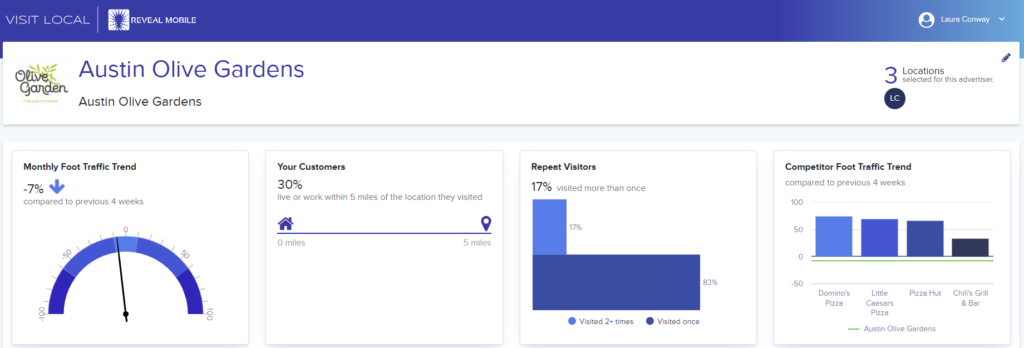
These foot traffic analytics are telling us a few things. First of all, foot traffic is down, so it is time to try something new. Next, roughly 30% of their business comes from people who live or work within 5 miles of the location they visited. Third, it looks as if their regulars have stopped coming in as frequently since only 17% of their visitors have eaten at Olive Garden more than once in the last 30 days. And finally, their competitors’ foot traffic is up, so they may be losing business to a pizza chain or Chili’s.
To get started, Olive Garden should begin running ads targeting those who live within 5 miles of their Austin area locations. They can use VISIT Local to geofence areas around each of their locations to capture the mobile ad IDs of their neighbors. They can then push that custom audience into Facebook and run a campaign with copy emphasizing convenience and being close by.
Next, they may want to offer those who are dining at their restaurants a coupon to come back within the next couple of weeks to encourage a return visit. Finally, they can geofence their top competitors — Domino’s, Little Caesars, Pizza Hut and Chili’s — to entice them to try Olive Garden. Since most of those competitors are carry-out focused, Olive Garden may want to include ad copy for a promotion for carry-out or offer delivery to their competitors’ visitors.
Using these tactics, the Austin area Olive Garden marketing team can measure the results using foot traffic attribution in VISIT Local – setting up three reports for the three different campaign tactics described above.

To see how their neighborhood audience performed, they can use VISIT Local’s foot traffic reporting to know how many of those in their audience converted.

To see if they were able to drive return visits from their coupons with a short redemption window, they can watch the repeat visitors chart change on their foot traffic analytics reports while the campaign is still in flight.
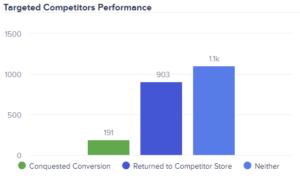
To measure their success with geoconquesting, they can look at the Targeted Competitors Performance chart in the attribution reports in VISIT Local.
Gyms
Since gyms were closed in many states for several months, people have settled for working out at home as well as trying to get exercise outdoors. Because of this, gyms are the perfect candidate to run campaigns targeting those who could have an affinity for their brand. Spinning studios would have success geofencing biking trails and circuit training gyms may find a high-intent audience on hiking trails. Yoga studios could find their audience of visitors to Lululemon and Athleta stores since retail locations opened before most gyms.
Gyms could run digital ads to these audiences to communicate their safety and cleaning standards as well as a new member special. Since the gym marketers know that they are reaching active people, they are much more likely to convert.
Geotargeting is a highly effective way to help you drive foot traffic, communicate with your customers and stay top of mind. To learn more about location-based marketing, geotargeting, foot traffic attribution or VISIT Local, contact us today.

